THE INSTITUTEI worked in the engineering industry for only six months before I realized what I was really passionate about was helping the next generation of women interested in a career in science, technology, engineering, and math to succeed. Girls often are discouraged from joining STEM fields even though they might show just as much interest as boys do. I wanted to help change that, so I moved from Los Angeles to Mexico, where I had family, and started working with preuniversity girls as a teacher’s aide. In this position, I’ve been helping female students understand the various opportunities within STEM fields, and I map out potential academic and career tracks for them.
Science, engineering, and technology are essential for promoting the health and well-being of all individuals. Accordingly, it’s vital to have a balanced scientific talent pool so that tomorrow’s innovations represent—and serve—everyone.
Here are some websites I’ve used to point young women toward STEM.
The National Academy of Engineering (NAE) sponsors the EngineerGirl website, whose mission is to encourage girls and women to join the field.
The site features inspirational stories about inspirational stories from female engineers about their careers, as well as information on different engineering specialties and scholarship opportunities. Visitors can pose questions and get answers from working engineers. Featured topics include how to develop a support network and how to decide what to study in college.
The NAE sponsors other engineering programs and initiatives including the Grand Challenges Scholars Program, the annual Engineering for You video contest and the Frontiers of Engineering symposia. The programs also promote scientific education in research and recognize the achievements of exceptional engineers.
This kid-friendly site, sponsored by the American Society for Engineering Education, is full of fun ways to learn about engineering, especially for young women and minorities. It includes videos of student-designed projects such as a human-powered helicopter.
An advice column written by engineering students covers steps to take to get into the engineering program of your choice and how to prepare for school.
There’s also a blog, where students write about their engineering projects. Former eGFI participants have gone on to work on the 2009 science-fiction blockbuster Avatar, high-end sports equipment, and the popular game Angry Birds.
The Tryengineering.org website is an excellent way to introduce girls to the field. The site—aimed at students, their parents, and teachers—features information on what it takes to become an engineer, such as accounts of professional engineers’ work experiences, lesson plans for teachers that feature hands-on experiments, and games that demonstrate what engineers do.
There’s also TryEngineering Together. Developed in partnership with Cricket Media, the e-mentoring platform connects industry professionals with students in third, fourth, and fifth grades. Using the specially designed curriculum—which is complemented by in-classroom, hands-on activities—students and their mentors explore articles on technical topics and then correspond with each other about them. Mentors ask the students questions and answer their queries.
PBS, a public-television broadcaster, and the U.S. National Science Foundation jointly sponsor this educational initiative. The TV program brings advocates and educators together to help inspire girls to pursue STEM careers. The associated website is one of the best resources I know of for helping to engage tween girls. The program’s episodes can be streamed from the site, which also offers games and profiles of prominent women working in STEM fields.
Valarie Romero is an academic, consultant, and researcher with a passion for improving social equity in education. She advocates for and mentors preuniversity girls interested in STEM. She plans to launch a nonprofit that focuses on increasing the number of female STEM researchers.
